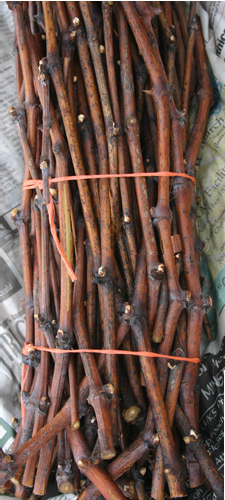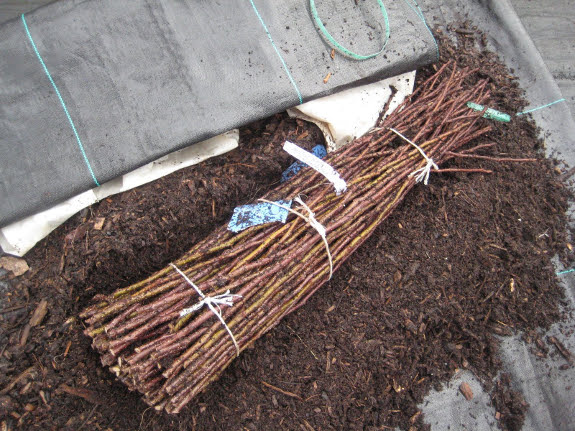
How to gather scionwood
 After
figuring out your rootstock, you'll still need to hunt
down some
scionwood before starting to graft. Scionwood (sometimes simply
called "scion") consists of small twigs of the variety you want your
final fruit tree to become. By grafting a piece of Arkansas Black
scionwood onto a rootstock, for example, all aboveground growth of the
tree will produce Arkansas Black apples.
After
figuring out your rootstock, you'll still need to hunt
down some
scionwood before starting to graft. Scionwood (sometimes simply
called "scion") consists of small twigs of the variety you want your
final fruit tree to become. By grafting a piece of Arkansas Black
scionwood onto a rootstock, for example, all aboveground growth of the
tree will produce Arkansas Black apples.
How and when you collect
your scionwood depends on the type of graft
you plan to perform. Budding is done in the summer, so you want
to clip off scionwood during the growing season and graft right
away. The scionwood is often called a "budstick" in this case,
and the number of buds on it is not relevant since you'll be using one
at a time.
Most of us (especially
if we live in more northern states
and are grafting apples and pears) will be grafting during the winter,
in which case we collect scionwood during the dormant season and store
it in a cellar, underground, or in the fridge until late winter. Michael
Phillips recommends
gathering dormant scionwood in January or February, wrapping it in
moist newspaper and then in a ziplock bag, and storing the cuttings in
the fridge. No matter how you store it, you should be careful not
to let your scionwood, freeze, dehydrate, or mildew.
Scionwood for dormant
grafting should be carefully selected. The best scionwood comes
from the previous season's growth (meaning the twigs aren't quite a
year old) and doesn't contain any flower buds. The tip of the
previous year's growth isn't as good, so if you have the choice, you'll
want to cut your scionwood from the lower two-thirds of the young
branch. Select a piece about 12 to 18 inches long to give you
wiggle room if you can, but if scionwood is in short supply you can get
away with shorter pieces as long as each one contains three or four
buds. The twigs you select should be about the thickness of a
pencil, roughly a quarter to half an inch in diameter.
But how do you find a
tree to cut scionwood from? If you're lucky, you'll have a
helpful neighbor with a tasty variety you want to try out in your own
yard. (I hope to get some Seckel pear scionwood that way from my
movie star neighbor.) Alternatively, you can buy scionwood from
online nurseries, or check out this site to swap
scionwood with fellow enthusiasts. Finally, I'd be glad
to swap scionwood with any of you if you have varieties I'm looking for
and want one of my cuttings in exchange.
| I can give: |
I'm looking
for: |
|
|
Drop me an email if you're interested, or leave a comment below to swap with other readers.
| This post is part of our Grafting lunchtime series.
Read all of the entries: |
Want more in-depth information? Browse through our books.
Or explore more posts by date or by subject.
About us: Anna Hess and Mark Hamilton spent over a decade living self-sufficiently in the mountains of Virginia before moving north to start over from scratch in the foothills of Ohio. They've experimented with permaculture, no-till gardening, trailersteading, home-based microbusinesses and much more, writing about their adventures in both blogs and books.
Want to be notified when new comments are posted on this page? Click on the RSS button after you add a comment to subscribe to the comment feed, or simply check the box beside "email replies to me" while writing your comment.

